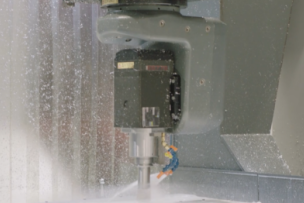As a brand of Saint-Gobain, a world leader in sustainable habitat, Norton offers the widest portfolio of grinding, cutting, blending, finishing and polishing solutions for all markets, materials and applications with the most advanced and affordable technology. So, as your needs evolve, our access to the global expertise of Saint-Gobain becomes even more valuable to making a difference in your day-to-day needs. And, we don’t have to look far for more localized expertise with our largest research center located right nearby in Northboro, MA.
By Andrew Biro, Norton Saint-Gobain
Cubic Boron Nitride (cBN) is a superabrasive material that has traditionally been used to grind materials, such as steels and nickel alloys. Though not as hard as diamond (4500kg/mm2 vs 9000 kg/mm2, respectively) cBN has the benefit of not being as chemically reactive with ferrite-based and nickel alloys and as such, can often outperform diamond-based grinding wheels in terms of life, material removal rates, and lower temperatures.
In fact, a study by Hitchiner and Wilks in 1987 showed that when grinding nickel, the chemical wear of a diamond single point turning tool exceeded the abrasive mechanical wear by a factor of 105, thus highlighting the importance of using cBN in these applications.
One common application for using cBN grinding wheels is on nickel-based superalloys in the aerospace industry. These superalloys are being used in next-generation aircraft engines, driven by good thermal stability at high engine operating temperatures.
Grinding Ni-based superalloys is often done with either conventional aluminum oxide abrasive or with cBN superabrasive wheels. There are many benefits to using cBN: fewer wheel changes and machine down time, low and controlled wear rates, and excellent thermal stability. As with any grinding wheel, the cBN superabrasive wheels wear with use. The wear rate and wear mechanisms are large drivers in determining final wheel performance.
Structure
To understand the wear mechanisms in single layer cBN wheels, it is first important to understand their construction. Single-layer wheels typically consist of a steel core that has been machined or ground to a specific size and tolerance. Next, wheels are masked to keep only the abrasive regions exposed and the cBN grains are then tacked in place. The wheels are then submerged in an electrolytic solution, and a current is passed through the wheel and solution, which draws the Ni-based bond onto the wheel as a cathodic reaction occurs. The thickness of the bond layer is proportional to the amount of time the wheel is plated.
This plating thickness plays a significant role in the wear mechanisms of the cBN grain during grinding. Thicker coatings tend to hold grains at the expense of material removal rate (due to lower grit protrusion from the top surface of the bond) and higher grinding temperatures (due to less room for coolant to enter and grinding swarf to escape). Thinner coatings can be used to increase grit protrusion, at the risk of grain pullout, macro-fracture, and lower wheel life.
Wear Mechanisms
Experts Mike Hitchiner, Stephen Malkin, R. Upadhyaya and Wenfeng Ding agree there are four main possible modes of wear in grinding with electroplated products:
-
Attritious wear of the grains (grain flattening)
-
Grain micro-fracture (microcrystalline splintering)
-
Grain macro-fracture or large scale cleaving (partial grain break-off)
-
Grain/bond interface wear or bond wear (causing total grain breakoff)
In attritious wear, grain wear is very minimal and is concentrated at very small scales around the cutting surfaces. Grinding forces are often insufficient to cause grain fracture and hence dulling results.
This can lead to an increase in the power draw and is often associated with more plowing and rubbing between the grains and work material, leading to a higher likelihood of thermal damage. To combat attritious grain wear, an increase in grinding forces (more aggressive grinding parameters) should be used to promote grain fracture. In dressable products (i.e. vitrified or resin-bonded wheels), dressing parameters and frequency can be used to help combat attritious grain wear as well.
Micro-fracture is the process by which grinding forces are sufficient to cause small scale grain fracture, resulting in continuous generation of sharp cutting points. This is often accompanied by steady-state grinding power. Grain micro-fracture is favorable for a consistent, predictable grinding process.
Macro-fracture occurs when the forces are substantially high, causing larger scale grain cleavage or partial grain breakoff. This typically results in low wheel life, and is an indication that the grinding parameters are too aggressive.
Grain pullout in electroplated products is not common, but can happen if the grain exposure level (i.e. percentage of the grain that is above the plating bond material) is high (>50%) and the forces are high. In grain pullout, the grains are ripped out of the bond, resulting in low wheel life. This was discussed by Ghosh and Chattopadhyay who highlighted the relationship between plating thickness and tendency for grit pullout.






Talk to Us!
Leave a reply
Your email address will not be published. Required fields are marked *